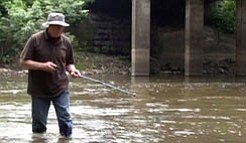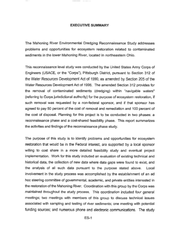Rebuilding The Mahoning River
By CAITLIN COOK
YOUNGSTOWN
Mahoning River Pollution

Lauren Schroeder and several of his YSU colleagues have spent decades studying the polluted river and trying to develop solutions for it.
Mahoning River Project
The Mahoning River Environmental Dredging Reconnaissance Study addresses problems and opportunities for ecosystem restoration related to contaminated sediments in the lower Mahoning River, located in northeastern Ohio.
External Link: Details of the Environmental Dredging Reconnaissance Study (click here)
Luis Velazquez tosses his fishing line in the Mahoning River in waters that maintain an easy flow downstream before falling over a small dam just beyond his cast.
On the river’s banks, oil residue creates a thin silhouette where the water meets land.
It’s the Mahoning — what former Youngstown Mayor Jay Williams tags as the “most grossly underused” physical asset in the Mahoning Valley.
The river has been so contaminated that in 1988, the Ohio Department of Health warned against contact with sediments and fish consumption along the lower 28 miles of the river, which includes the area flowing through Youngstown. It’s most often waist-high but can get up to 12 feet deep, and it’s seldom wider than a good stone’s throw.
Velazquez, 30, a native West Sider, has heard stories all his life of pollutants lurking below the waters he has fished for 10 years and camped along as a child.
He said he is not deterred and will continue fishing the waters.
But he never eats the fish.
A river that was choked by pollutants for decades remains even further strangled by multigovernment finger-pointing. Millions of dollars have been spent on suggestions. Little has been spent on action, however.
Despite years of conversation and study and promises of funding and support, the Mahoning is no closer to clean today than it was 30 years ago when companies stopped dumping pollutants into the tributary.
The U.S. Army Corps of Engineers conducted a $500,000 study in 1999 and determined that regardless of how much the water quality improves over the years, the Mahoning cannot be deemed restored until the miles of contaminated sediments are addressed.
Bill DeCicco spent much of his 20-year public career as the leader of CASTLO, the economic development agency for Poland Township and the cities of Campbell, Struthers, Lowellville and Coitsville. He always thought the river would be cleansed in his lifetime.
“If you were here in 2005 and said, ‘Bill, well what do you think about cleaning up the Mahoning River?’ I’d say, ‘Well 2005, we finish up this study and by 2017, 2020 at the latest, we’ll have a clean river.’”
STEEL’S LEGACY
The nine major steel mills along the Mahoning were Republic Steel Corp. Warren plant; Republic Steel Niles plant; U.S. Steel Corp. McDonald Works; Youngstown Sheet & Tube Co’s Brier Hill Works; U.S. Steel Corp. Ohio Works; Republic Steel Corp., Youngstown; Youngstown Sheet & Tube Campbell Works; and Sharon Steel Corp., Lowellville.
The U.S. EPA reported that the average net discharge from those nine steel plants exceeded 400,000 pounds per day of suspended solids, 70,000 pounds per day of oil and grease, 9,000 pounds per day of ammonia-nitrogen, 500 pounds per day of cyanide, 600 pounds per day of phenolics and 800 pounds per day of zinc.
For perspective, the million-gallon Monongahela River Ashland oil spill of 1988 was characterized as one of the most severe inland oil spills in the nation’s history, that same report said.
By comparison, however, the much smaller Mahoning River chronically received the equivalent of more than four Ashland oil spills every year for decades.
The contamination stems from years of long-idled steel and other industrial companies dumping waste into the river and using the water from the river to cool products they manufactured.
Although steel companies have long since shuttered their operations in the Valley, the toxic remnants they left have survived.
A $3.5 million Corps feasibility report explored methods to extract contaminated sediments. The report called for dredging 750,000 cubic yards of in-river and riverbank contamination, and for the removal of seven small dams.
Some experts believe the dams hold the river hostage to years of industry. The suggested dredging, along with the removal of dams, will restore the river to its natural free-flowing course, according to the Corps report.
Mike Settles of the Ohio Environmental Protection Agency said the Mahoning was most recently studied from 2006 to 2007 along the upper region upstream from the Leavittsburg dam in Trumbull County. The lower Mahoning was studied in the 1980s and 1990s. A new study will be conducted next year.
WHO PAYS?
Cleanup has been stalled in Phase 2 of a feasibility study by the Corps.
Eastgate Regional Council of Governments became involved as the community sponsor in the Corps’ study. Rachel McCartney of Eastgate says the river falls under the jurisdiction of the Corps, and that is where the cleanup funds initially were going to originate.
“Involving a federal agency, such as the Corps, has its positive and negative sides. Of course, we are now experiencing the negative side — a stalled project,” McCartney said.
Officials offer varying explanations for the delay:
Disagreements about the proper approach to development.
Weak environmental laws.
Timid political leadership.
People unwilling to demand action.
The major stumbling block, however, is determining who should pay for the project with an estimated cost of $150 million.
U.S. Rep. Tim Ryan of Niles, D-17th, said the factories that polluted the river, including many now-defunct steel companies, are legally responsible to pay. He said it is unlikely to be able to collect from them or from the companies that took over their former locations.
U.S. Steel, with headquarters in Pittsburgh, is the only company still in existence that once operated along the river.
“I would think it’d be highly improbable, if not impossible, for the local communities to go after these polluters. This is a federal issue,” Williams said.
In an interview while he was still mayor, Williams listed the cleanup of the river among the top 10 priorities for the city, but realized that little or nothing is happening to advance the effort.
Williams, who is now director of the U.S. Department of Labor’s Office of Recovery for Auto Communities and Workers, isn’t sure if the river will ever be clean enough for recreation.
“I’m always hopeful,” he said. “But it is a difficult and tedious process.”
WHO SHOULD DO IT?
Youngstown Mayor Charles Sammarone, who has been involved in city government for 28 years, said he is no longer optimistic about chances for a cleanup.
“It’s been talked about for almost 40 years,” Sammarone said. “Everyone is in favor of doing it. It’s just how do you fund it?”
Williams said the problem is that no one appears to be leading the cleanup effort despite the fact that several organizations are chartered for such a purpose and people draw paychecks for the work.
Daniel Mamula, who was hired in 2009 as the manager of the Mahoning River Corridor Initiative, said he believes the Corps is supposed to be coordinating and leading the effort to find funding.
Carmen Rozzi, the initial project manager for the Corps, says that’s not his agency’s job.
Instead, he says it is up to Congress to decide if it wants to allocate funding for the project.
“For federal involvement, a federal agency needs two acts of Congress in order to accomplish anything,” Rozzi said. “Any federal agency needs authority to accomplish the mission then must seek the appropriations.”
Rozzi recently helped craft new legislation for Congress that he hopes will help give their efforts a stronger bite.
Mamula said his agency is working to lure companies to locate businesses along the river. Since the initiation of the corridor initiative, using grants from the Clean Ohio Fund and the Federal Brownfields Program, 450 acres of brownfield sites are either remediated or under the process of being cleaned. Of that, 125 acres of brownfields meet commercial or industrial standards in the various communities along the Mahoning River.
“We want to do this as business development as well as recreational and environmental. Trying to keep that balance is really tough because the pressure is on for jobs and business,” Mamula said.
OPEN FOR BUSINESS
Lori Jordan, 43, of Austintown doesn’t fish the Mahoning but enjoys the tranquility she finds along its banks.
“If they were to clean up the river, it would at least give people some positivity and hope,” Jordan said.
The last studies, performed in 1996 by the Ohio EPA, found high levels of toxic chemicals such as lead, zinc, copper, iron, cadmium, chromium and organic toxins.
Mamula is skeptical the river ever will be fully clean but believes sections will be addressed.
Mamula acknowledged Trumbull County is naturally ahead of recreational development with Packard and Perkins parks, in addition to bike trails and easy river access. He would like recreation development near the Covelli Center, such as a bike path.
Despite the contact ban, Mamula said he does not understand why the river cannot be used for casual recreation now. “People are using the river more and more,” Mamula said.
Williams, however, said he would hate to see too much time or money spent on developing recreational areas until the water is deemed safe.
“The concern would be, we’d locate businesses right there on the banks, and the business says, ‘Hey, it’s fine; it’s great.’ Then three years later, we get this project rolling. All of the sudden, that land needs to be a staging area for the equipment or for the material that’s dredged, and now we’ve got a business in an area that doesn’t make sense for cleaning the river.”
Sammarone, however, said he welcomes business along the banks of the Mahoning.
“You come in here with a business, we’ll bend over backwards to get you here,” he said.
OPINIONS RUN DEEP
Such disparity in opinions is common in this debate.
One person or organization wants to move one direction; another has a different vision. N othing happens.
Several groups and projects continue to push the cleanup and are receiving local and federal funding as well as private donations to sustain work related to the Mahoning River.
For instance, the Mahoning River Corridor Initiative received an $80,000 grant from the Ohio Department of Development to study establishing “a regional urban economical development and brownfield revitalization plan.”
Other organizations that spend time or money working on development or cleanup of the river are the Mahoning River Consortium, Mahoning River of Opportunity, Mahoning River Corridor Mayors’ Association, Eastgate, CASTLO, and Youngstown/Warren Regional Chamber.
Rozzi said it’s doubtful the river will be cleaned if the funds cannot be allocated for the proposed $150 million cleanup project.
The Department of Justice, however, was successful in providing the Ohio EPA with about $8.4 million — $2.9 million from LTV and $5.5 million from Copperweld — from their settlements with those steel companies. The funds can be used for cleanup projects along the Mahoning.
“There’s been no indication that this money must be used by a certain date or it disappears or will be dedicated to something else,” said Settles of the Ohio EPA.
Rozzi said there is nothing the Corps can do right now, however.
“We don’t have the authorization to do anything on the Mahoning River,” he said. “This is a challenging period for us authorization- wise.
“The determination has to be made how do you dredge, where do you dredge, what do you do with the sediment and where is the money going to come from?”
Those are the questions no one can still answer.
The NewsOutlet, which pairs student journalists with professionals, is a collaboration among Youngstown State University, Kent State University, the University of Akron, The Vindicator, Akron Beacon Journal and Rubber City Radio.
 43
43

